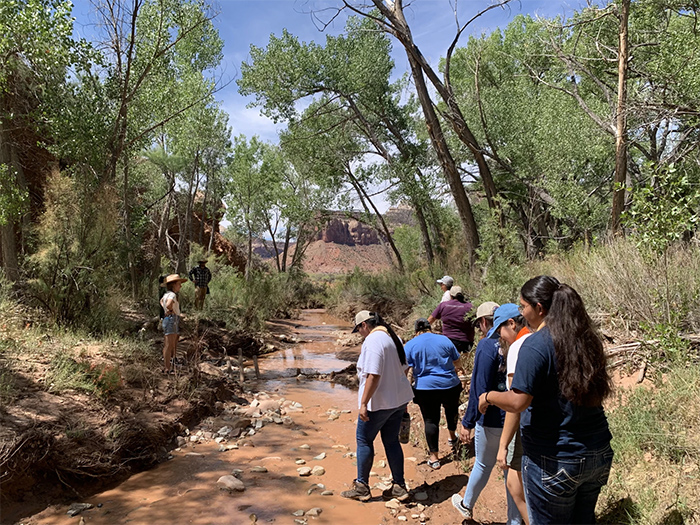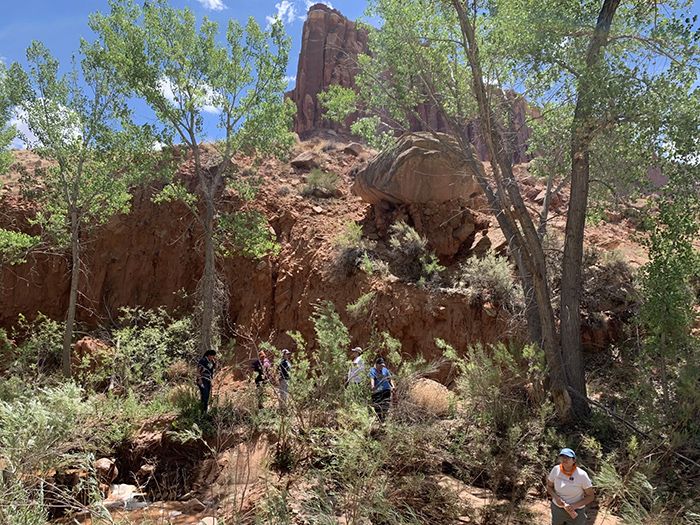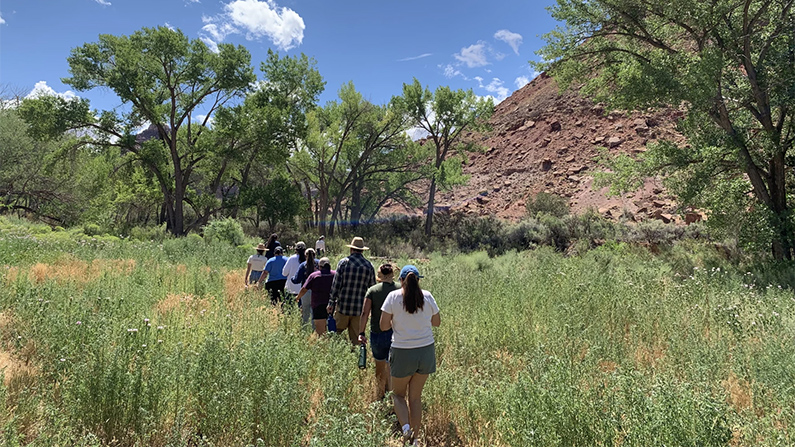The Canyonlands Research Center in southeastern Utah is in its second year offering a paid summer internship to Native American students interested in conservation.
In early August, students toured Dugout Ranch and learned about watershed health as part of the center’s NATURE program, which stands for Native American Tribes Upholding Restoration and Education.
On the shady shores of Indian Creek, the group observes a beaver dam analogue, or BDA, that was installed last year by Jeff Adams, founder of TerraSophia, a company that works on things like erosion control and permaculture.
A BDA consists of wooden poles and weaves of juniper meant to catch sediment.
“And what that’s done is it’s held all that sediment here and then that helps hold more moisture. But it’s also allowing the creek to have better connectivity to the floodplain,” said Adams.

Students from the the Canyonlands Research Center NATURE program learn about riparian health on the shores of Indian Creek. (Justin Higginbottom/KZMU)
The BDAs here prevented flood waters from cutting the creek too deep, and the new sediment will allow riparian vegetation to grow, like willows and cottonwoods.
Alix Pfennigwerth, lead instructor for the NATURE program, says it’s just the type of project students from the NATURE program are learning about this summer.
“A lot of what we’ve been doing is actually interacting with some of the leading scientists, conservationists, ranchers and land managers from this region,” said Pfennigwerth.
This summer they have six students from various tribes of the four corners region.
During the seven-week internship those students go out in the field with experts to hear about practical conservation solutions.
“So, our goal is basically just to support the next generation of Indigenous leaders in the four corners in the fields of natural resource management, science, conservation, restoration,” said Pfennigwerth.
Kirtsen Begay is one of the students in the NATURE program. She’s from Arizona and a member of the Navajo Nation.
“It’s just been a lot of fun, I guess, a lot of learning…just like being able to learn different things about the Earth that we come from,” said Begay.
Begay is studying agricultural sciences. Her highlight of the summer has been learning about biocrust.
“So, just being able to see what kind of living things are underneath us and how they survive in their own way,” said Begay. “And definitely don’t ‘bust the crust.’ That’s something that we learned. And I feel like now that I know more about it, I definitely won’t bust it.”

Six students are participating in the Canyonlands Research Center NATURE program, Native American Tribes Upholding Restoration and Education. (Justin Higginbottom/KZMU)
The Dugout Ranch is on the border of Canyonlands National Park. Kristen Redd who works at the ranch with her husband says the land has a long history.
“Originally, this place was the homelands for the ancient Puebloans,” said Redd.
Just down the road is Newspaper Rock, one of the largest known collections of petroglyphs.
More recently the land was used by the Ute and Navajo tribes. And then as homesteads for White ranchers.
Now it’s owned by the Nature Conservancy and the location of their Canyonlands Research Center.
It’s become a sort of open-air laboratory on the cutting edge of research on desert ecosystems.
It’s also used to educate and train the next generation of conservationists.
Redd wants that to include more Native Americans.
”The Nature Conservancy as a global organization has a huge initiative to reach out to indigenous peoples because we believe that they are the original stewards of the land. And for us to work well in conservation, we need their knowledge base,” said Redd.
Redd says that today is not only about teaching.
“How much we learned from these students is incredible. As well as, you know, hooking them up to go out into the world and do restoration on their homelands or whatever projects they are interested in.”
Another student participant Amber Renee Archie studies anthropology. She’s Navajo.
“I think one thing that stood out was meeting a lot of indigenous scientists and researchers,” said Archie.
For example, Archie met a Cherokee scientist from California. And just knowing she exists was powerful.
“Just seeing how much opportunities that they got was really inspiring. It’s something that I would want to do. And something I hope to do,” said Archie.
“Hopefully, I think one thing that I’m going to get out of this internship is to make connections, or getting ideas or helpful tips from them. It’s a really big opportunity for me.”
Archie hopes to study more about traditional ecological practices, and apply what she learns on and off the reservation.
And hopefully later, she can be the one inspiring future scientists.
This story from KZMU was shared with us via Rocky Mountain Community Radio, a network of public media stations in Colorado, Wyoming, Utah and New Mexico including KHOL.






